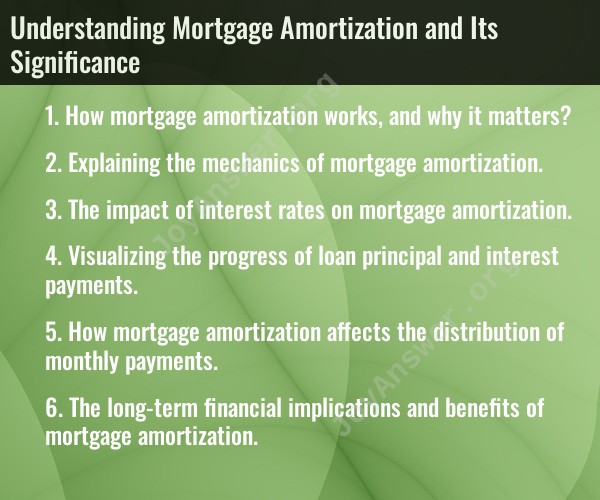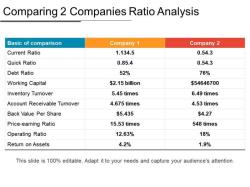How mortgage amortization works, and why it matters?
Mortgage amortization is a process that outlines how a mortgage loan is gradually paid off over time. It involves breaking down your monthly mortgage payment into two main components: the principal and the interest. Understanding mortgage amortization is crucial for borrowers because it has significant financial implications and can affect the total cost of homeownership. Here's how mortgage amortization works and why it matters:
How Mortgage Amortization Works:
Monthly Payments: When you take out a mortgage loan, you agree to make regular monthly payments to repay the borrowed amount. Each monthly payment typically covers both the interest and a portion of the principal balance.
Interest Payment: In the early years of the mortgage, a significant portion of your monthly payment goes toward paying interest. This is because your loan balance is still relatively high, and interest is calculated based on the outstanding principal.
Principal Payment: The remainder of your monthly payment reduces the principal balance. Over time, as you make consistent payments, the portion of your payment allocated to the principal gradually increases.
Amortization Schedule: Your lender provides you with an amortization schedule, which is a table that outlines the specific breakdown of each monthly payment over the life of the loan. It shows how much of each payment goes toward interest and how much goes toward principal.
Gradual Paydown: As you continue to make payments, the outstanding principal balance decreases. This results in a smaller amount of interest being calculated on the reduced balance. Over time, your monthly payments remain the same, but more of the payment goes toward paying down the principal.
Why Mortgage Amortization Matters:
Total Interest Costs: Understanding mortgage amortization is essential because it affects the total interest you pay over the life of the loan. In the early years of a mortgage, a substantial portion of your payments goes toward interest. As the loan matures, more of your payment goes toward reducing the principal, reducing the total interest paid over time.
Equity Buildup: Mortgage amortization also impacts the rate at which you build equity in your home. Equity is the difference between the home's value and the outstanding mortgage balance. As you pay down the principal, your equity increases.
Refinancing and Selling: Mortgage amortization can influence your decisions regarding refinancing or selling your home. The amount of equity you've built determines your options for refinancing or using the equity for other purposes.
Budgeting and Financial Planning: An understanding of mortgage amortization is crucial for budgeting and financial planning. Knowing how your payments are allocated helps you plan for your housing costs and long-term financial goals.
Loan Comparison: When comparing different mortgage offers, examining the amortization schedule can help you evaluate the long-term costs and benefits of each loan option. It allows you to make informed decisions about which loan best fits your financial situation.
In summary, mortgage amortization is the process of gradually paying off a mortgage loan through regular monthly payments. It's significant because it determines the distribution of interest and principal in your payments, affects your total interest costs, and plays a crucial role in building equity and making financial decisions related to homeownership. Borrowers should review their amortization schedule to gain insights into their mortgage and make informed financial choices.
Explaining the mechanics of mortgage amortization
Mortgage amortization is the process by which a borrower pays off a mortgage loan over time through regular monthly payments. These payments are divided into two parts: principal and interest. The principal portion of the payment goes towards reducing the balance of the loan, while the interest portion goes towards paying the lender for the use of their money.
The amount of principal and interest paid each month varies over the life of the loan. Initially, most of the payment goes towards paying interest, with only a small portion going towards reducing the principal. This is because the interest is calculated on the full balance of the loan, which is highest at the beginning of the loan term.
As the loan balance decreases, the amount of interest paid each month also decreases. This means that a larger portion of the payment goes towards reducing the principal. This process continues until the loan is paid off in full.
The impact of interest rates on mortgage amortization
Interest rates have a significant impact on mortgage amortization. Higher interest rates mean that borrowers will pay more interest over the life of the loan, and a smaller portion of each payment will go towards reducing the principal. This can lead to a longer loan repayment period and higher overall monthly payments.
Lower interest rates, on the other hand, mean that borrowers will pay less interest over the life of the loan, and a larger portion of each payment will go towards reducing the principal. This can lead to a shorter loan repayment period and lower overall monthly payments.
Visualizing the progress of loan principal and interest payments
To visualize the progress of loan principal and interest payments, you can use an amortization schedule. An amortization schedule is a table that shows how each monthly payment is allocated to principal and interest over the life of the loan.
Most mortgage lenders provide borrowers with an amortization schedule when they close on their loan. Borrowers can also use online mortgage calculators to generate amortization schedules for different loan terms and interest rates.
How mortgage amortization affects the distribution of monthly payments
As mentioned above, most of the payment goes towards paying interest in the early years of a mortgage loan. This means that borrowers can expect their monthly payments to be relatively high in the early years and to decrease over time.
The exact distribution of monthly payments will vary depending on the loan term, interest rate, and down payment. However, all mortgages will follow the same general pattern of decreasing monthly payments over time.
The long-term financial implications and benefits of mortgage amortization
One of the long-term financial benefits of mortgage amortization is that it allows borrowers to pay off their loan over time, without having to make a large balloon payment at the end of the loan term. This can make it easier for borrowers to manage their monthly budget and to avoid financial hardship.
Another long-term benefit of mortgage amortization is that it allows borrowers to build equity in their home. As borrowers pay down the principal balance of their loan, they are essentially building equity in their home. This equity can be used for a variety of purposes, such as borrowing against it to make home improvements or to finance a child's education.
Overall, mortgage amortization is a financial tool that can help borrowers to achieve their homeownership goals. By understanding how mortgage amortization works, borrowers can make informed decisions about their loan terms and interest rates.













